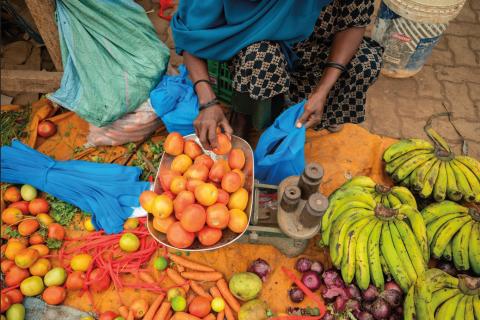Food environments and diet quality in traditional urban markets in Kenya
This is a summary of the following paper: Demmler KM, van der Steen S, Trevenen-Jones A et al (2025) Food environments and diet quality among vendors and consumers in five traditional urban markets in Kenya. Nutrients, 17(1), 116. https://doi.org/10.3390/nu17010116
Traditional food markets are a vital part of urban and peri-urban food environments in low- and middle-income countries. They provide affordable fresh food and support local livelihoods. Little is known about the associations between market characteristics and the dietary quality of vendors and consumers.
This study explored these relationships in five urban food markets in Kenya, where around two-thirds of food is sourced from traditional food markets, kiosks, and street vendors. All five markets were comparable in size, infrastructure, and vendor density. A wide selection of fresh fruits and vegetables, grains and pulses, and animal-source foods were available.
Survey data were collected from 1,042 vendors and 876 consumers using a random sampling approach. Vendors were asked about their business operations, seasonal availability of food, storage, and interest in nutrition training. Consumers were asked about their purchasing habits, frequency of market visits, and perceptions of market environments.
The diets of vendors and consumers were assessed using the Kenya diet quality questionnaire (DQQ). Two indicators of diet quality were calculated: dietary diversity score (DDS, 0-10) and adherence to global dietary recommendations (GDR, 0-18).
The results showed that overall diet quality scores were high among consumers and vendors. Consumers had significantly higher DDS (7.4) compared to vendors (7.1), representing a wider range of food groups consumed. However, consumers had lower GDR (11.3) than vendors (12.1), which indicates greater consumption of soft drinks, sweets, and highly processed foods by consumers – food groups not recommended by the World Health Organization.
Most consumers (59%) relied on traditional food markets for all or most of their food purchases, and these consumers had better diet quality (higher GDR) driven by greater consumption of pulses, vitamin A-rich vegetables, citrus fruits, and unprocessed meat, alongside lower consumption of processed foods. Consumers who bought more roots and tubers, legumes, seeds and nuts, and vegetables had better diet quality (DDS and GDR). Vendors’ diet quality was less clearly associated with food groups sold.
It was common for consumers and vendors to travel for 30 minutes or more to reach the markets. Longer travel times between home and market were associated with lower diet quality for both consumers and vendors. There was no clear link between the frequency of visits to the market and diet quality. Associations with socioeconomic factors were also mixed.
In summary, this study highlights the value and importance of traditional food markets in urban food environments. While causal relationships cannot be determined from cross-sectional data, and the findings are limited to five markets, the potential links with diet quality warrant further investigation. The authors identify research gaps and priorities that could help to improve the diets of people reliant on urban food markets.


